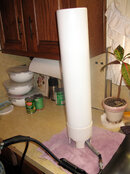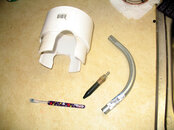Here are two photos of how I just cleaned some tanks. The "tools" are a tooth brush for getting the neck threads clean, a "stand" made from PVC couple and a 90 eletrical conduit bend. I use clean NITROX to blow dry the tanks.
1) Put in about a quart of your cleaner using hot water - as hot as your sink will deliver, slosh it around for a while. I will plug the neck with a stopper and roll quickly back and forth turning the tank 1/3 around 3 or 4 times to make sure I get good mechanical cleaning (impingement) on all areas of the tank.
2) Dump it out and repeat.
Use the tooth brush each time to get the threads
3) Dump out the cleaning solution and use a quart of clean hot water. Slosh it around just like the cleaner
4) Repeat
5) Dump out the last rinse and completely fill the tank with hot water. By this time the tank will be unpleasent to "this hurts" hot from the water. Dump it out, place the "stand" and tube into the neck, flip over and blow it dry.
I can feel the air comming out and tell the diffrence when the water is all gone. But a slow could to 30 is all I need for tanks up to an 80. You may want to do a slow count to 60 for 100's and bigger.
The tank on the "stand" is an aluminum 40.
Pete






